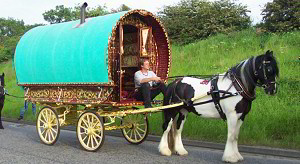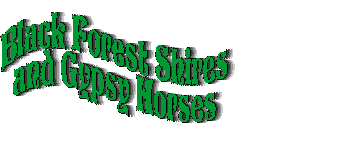The Gypsy
Horse is like any other breed for the most part when it comes to
breeding and foaling. There are however some differences that are
important to be aware of if you are going to have a successful breeding
season. Feel free to share this article with your vet or
reproduction professional. They will definitely find it helpful.
First, a little on
our background.
I received my education in equine reproduction from
Colorado State University ten years ago. Since that time, we've been
standing and shipping semen from draft horse stallions, owned and
not-owned. We have been involved in many leading-edge breeding
technologies in the draft horse over these years. Our skills include the
collecting, processing, and shipping of equine semen, as well as mare
management, insemination, and ultrasonography.
The information contained in this article is based on our experience
over this time breeding both the Gypsy Horse, and their close cousin,
The Shire Horse.
The gypsy horse is very similar to the draft horse in many ways where
reproduction is concerned - However, there are differences between the
draft breeds and lighter breeds that must be taken into account when
breeding these horses.
Some of these differences of concern are:
Mares:
-
follicle size prior to ovulation
-
breeding dates
-
higher incidence of twinning
-
higher incidence of "PAF's" (persistent anovulatory follicles)
-
weak cl's in late season pregnancy
-
higher incidence of yeast infections
stallions:
Mares:
Follicular size: most light breed horses will ovulate when the
dominant follicle is around 40-45 mm. Draft breeds ovulate at a larger
size. We typically see ovulation around 55-60 mm in the draft horse, as
well as the Gypsy Horse. Timing of ovulation is critical to proper
insemination of the mare. Many vets have a difficult time
predicting ovulation in draft breeds, and the problem seems to be
getting worse - primarily due to over-dependence on the ultrasound.
Ten years ago, many vets were just getting into ultrasound and were
learning how to use it. These vets had been trained to determine
ovulation through palpation of the ovary and follicle, and many were
highly skilled and accurate in doing so. It seems that art has
been lost as vets become more dependent on the ultrasound. If you
can find a vet who is skilled in this palpation, you're likely to
increase your chances of a successful breeding. If you are
breeding your mare through the use of Artificial Insemination, it is
necessary to scan your mare through ovulation so you know that she did
in fact have a normal ovulation within the time window for breeding.
Breeding dates: All
mares are at their most fertile point around the summer solstice.
This is even more apparent in the Gypsy Horse. In most horse
breeds, January and February foalings have been highly desired.
Man has used various techniques including hormone therapy, and changes
to the length of daylight in order to achieve these early pregnancies.
Through this type of breeding practice, man has created horses that tend
to breed better earlier in the season than their ancestors did. In
the case of the gypsy horse, no such attention has been given to foaling
dates. Mares are bred in the pasture, and foal in the pasture.
These dates are set by nature, and we are challenged to change it.
In any group of gypsy mares pastured with a stallion, you will find that
the large majority of them foal in May and June - which equates to June
& July breedings. Even when mares are cycling much earlier in the
season, and getting bred by the stallion, it is seen that the June
& July breedings are the ones that settle.
Here on our farm, looking at the records for 4 years of breeding 20+
mares each season, (both pasture breeding and assisted) we can draw the
following conclusions:
85-90% of mares conceived in June/July breedings. Those mares who
conceive (and subsequently foal) earlier in the season, do so
consistently season-after-season. Conclusion: Don't blame the
stallion if your mare doesn't conceive early in the season, even if your
vet says the timing was perfect. The odds are against her in these
cases. Lights and hormone treatment may help, but we have not had
much luck here (more work should be done in this area however).
Twinning: Just like
thoroughbreds and the other draft breeds, the Gypsy horse is much more
prone to multiple ovulation than light breeds. We have heard
stories from Gypsy breeders of twins being born occasionally. We
also hear of mares who come up empty in the spring. How many of
those aborted twins over the fall & winter? We cannot know as most gypsy
breeders do not check for twins. We typically observe twins in 4-5
mares a season, which equates to appx 8% of mares checked in a given
season. You will want to check your mares shortly after breeding
(around 16 days post-ovulation), and be sure to check closely for twins.
Let your vet know that this breed is particularly prone to twinning, and
he/she will use extra care to search for them. If twins are found,
you vet will be your best source of information to address the issue.
If you wait too long to get this check done, you run the risk of being
unable to address twins, and may even lose the ability to breed back the
mare - resulting in no foal for the spring.
Persistent Anovulatory Follicles:
Also called Hemorrhagic Follicles, seem to be more common in the draft
breeds than in light horses. We primarily see them in the late
season. Read more about them at
http://www.equine-reproduction.com/articles/AHF.shtml. This is
another good reason to ultrasound your mares through ovulation and
ensure they did in-fact ovulate.
Weak CL's. We see this in
draft breeds which conceive late in the season. Consider putting
your mare on Regumate if she doesn't seem to conceive during late
season. Check her progesterone level periodically to determine if
it's safe to take her off the medicine.
Yeast infections: These
seem to be popular in draft horses - especially those which have had AI
procedures performed multiple times. The Yeast Infection medicines
designed for (human) women can be effective here - but it takes a lot
more. You get interesting comments when buying this stuff by the
case. It never hurts to get a cytology done when you do a uterine
culture. Yeasts are easy to see, and not too difficult to treat.
Stallions:
Low Libido:
Well, what can I say... We love our stallions because they are gentle
and easy-going. This carries over to breeding activity as well.
You just need to work with this. It may take longer to get a
collection from your stallion. He may also never take to a
phantom, and can very well have strong opinions on which mares to breed.
A few years ago a stallion was imported and subsequently gelded when he
would not breed the mares required as part of his quarantine. This
tragedy could have been avoided if those involved understood the breed
better. Patience in the breeding barn will pay off here.
Learn your stallion's likes and dislikes.
Sperm Concentration:
The draft horse (and gypsy horse) will typically have a lower sperm
concentration than light breeds. Concentrations of between 130 and
200 million sperm per ml are pretty typical here, with total sperm
numbers of 8-14 billion per ejaculate. This is more than enough
sperm to get your mare in foal. However, lower concentrations can
be more difficult to process for shipping and freezing. No problem
for live cover. If shipping, be sure your collection facility can
properly process semen of lower concentrations. In cases where
extra work is required processing semen, it may not have the longevity
we're used to seeing in stallions not needing these extra steps.
Testicular size:
This is linked with testosterone production, sperm production and
libido. Draft horses (and gypsy horses) have a smaller testicle
size in relation to their body size than do light breeds. This
size will increase during the warmer months - thereby making your
stallion more fertile during the breeding season. This topic came
up recently here at the farm, so some measurements were in order.
We measured the gypsy stallions here, and recorded an average TSW (total
scrotal width) of 8.2 cm during early January. Conclusion: If
someone says your stallion's testicles are too small, a measurement is
in order to be compared with others. We can help you in this area.
I'll even teach you how to use the measuring tool.
Shipping: Many
breeders do not understand the math involved when processing semen for
shipment. When shipping chilled semen, we use a figure of 500
million pms (progressively motile sperm) for insemination. We will
assume that 50% of the sperm will die during transport, so package each
dose with 1 billion pms. Sometimes we will ship 1.5 billion per
dose if it is available. I get phone calls every season from mare
owners complaining about poor motility of the semen they received.
In most cases, they don't understand the math. If I ship you 1.5
billion pms at an initial motility of 75%, then you can receive that
shipment with a motility as low as 25% and still inseminate with the
required 500 million pms. When a mare owner doesn't understand the
math, they give the stallion a bad reputation which is not deserved.
What's important to realize here is that you inseminate with sperm, not
motility. A mare owner should receive a collection report with
semen ordered that includes these figures so they can do the math
themselves.
Additional info for vets: The Gypsy Horse is a relatively new
breed to the Americas, and we are still learning about their differences
and similarities to other breeds. The researchers at Colorado
State University's Equine Reproduction Laboratory (ERL) have been quite
helpful in this area. Technical questions regarding reproduction
in the Gypsy Horse can be directed to Dr. Jason Bruemmer, at CSU's ERL.
We hope you
find this information helpful, and we are happy to help you with your
breeding questions. In all cases however, your first source of
information and treatment should come from your veterinarian. This
information is not intended to replace information supplied by your vet,
but to supplement it.





